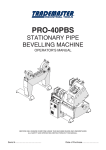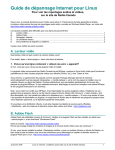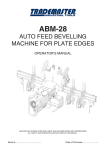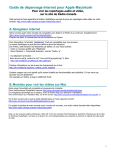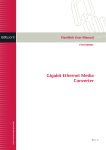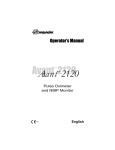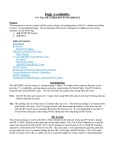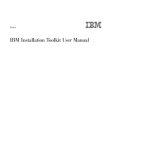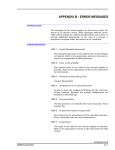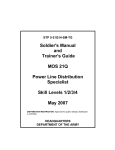Download Cable Prep Tools for Hard Line Applications User Guide
Transcript
Cable Prep Tools for Hard Line Applications User Guide Standard Product Warranty Ben Hughes Communication Products Co., (BHCP) warrants that the company’s tools are free from defects in workmanship and material. BHCP will repair or replace its tools, which fail to give satisfactory service, due to defective workmanship or material. Repairs or replacement should be at the election and expense of BHCP and is your exclusive remedy in place of all other rights and remedies. Plastic tool components are warranted for as long as you own your tools. Metal components are a consumable product. A consumable product is warranted at the time of sale, only against defects in workmanship and materials that prevent its use. Consumable products are goods reasonably expected to be used up or damaged during use including, but not limited to core bits, strip core bits, jacket strip blades, CPT series blades, gator teeth and crimp and compression tools, links and pins. BHCP shall not be liable for any incidental, special or consequential cost or damages incurred by the purchaser or others (including without limitation, lost profits, revenues, anticipated sales, business opportunities, goodwill or interruption of business and any other injury or damage). We reserve the right to make changes in design or construction at any time, without incurring any obligation in incorporating such changes in tools previously sold. We also reserve the right to discontinue the manufacture or offering for sale through our exclusive distributors of any tools at such time as we consider necessary. We cannot accept responsibility for tools which have been abused, worn, altered, repaired by others or used incorrectly. To make a claim, call Cable Prep toll-free at 800-394-4046. Upon authorization, US Customers may ship product prepaid to Ben Hughes Communication Co., 207 Middlesex Ave., P.O. Box 373, Chester, CT 06412. Customers outside continental US must ship product to point of purchase. Damage occurring during transit is not covered by this warranty. Cable Prep Tools for Hard Line Applications User Guide Contents: SCT Stripping/Coring Tools . . . . . . . . . . . . . . . . . . . . . 2 AIO All-In-One Cable Preparation Tools . . . . . . . . . 3 JCS Jacket Stripping Tools . . . . . . . . . . . . . . . . . . . . . . 7 MRT Messenger Removal Tools . . . . . . . . . . . . . . . . 10 ART Armor Removal Tools . . . . . . . . . . . . . . . . . . . . . 13 Gator® Center Conductor Beveller and Cleaner . 15 Cable Cutters . . . . . . . . . . . . . . . . . . . . . . . . . . . . . . . . . 16 RTH Ratchet T-handles . . . . . . . . . . . . . . . . . . . . . . . . 17 Read instructions carefully. Tool performance is subject to the care and judgement exercised by the user, so a thorough review of the instructions presented in this guide is essential. To view instructional videos, visit our website: www.cableprep.com. To order parts, additional products, blades and cartridges, contact your distributor or visit our website: www.cableprep.com. CAUTION: THE BLADES USED IN CABLE PREP TOOLS ARE EXTREMELY SHARP. BE SURE TO KEEP YOUR FINGERS CLEAR OF THEM. CAUTION: ALWAYS WEAR EYE PROTECTION WHEN USING ANY HAND TOOLS. 1 SCT Stripping/Coring Tools Strip and bevel the outer conductor and core the dielectric in one quick, easy step. Beveling the outer conductor prevents connector O-ring damage. One-piece blade ensures proper cutting alignment every time. Tool steel prolongs blade life. 1. Cut the cable with a coax cable cutter from Cable Prep or hack saw to avoid distortion of the center conductor. Side cutters are not recommended, as they tend to flatten the cable. Even the best of cutters will distort the cable, however, a slight distortion is allowable with this tool. The cable should be just round enough to clear through the guide sleeve. 2. Jacketed Cable. If the cable is jacketed, remove at least 2½” plus the length of the center conductor of the jacket from the cable. This is the minimum length for the tool to operate properly, however, your connector installation requirements may call for a longer length. Check your connector instruction sheet. 3. Flooded Cable. If the cable is flooded remove flooding compound from the aluminum sheath using BioChem Systems Cable Clear® distributed by Cable Prep. The cable is now ready for stripping and coring. 2 Manual Operation 1. Place the SCT tool over the end of the cable through the guide sleeve up to the blade. With a slight forward pressure, turn in a clockwise direction. Note: The first cutting edge will remove any aluminum shield in its way. This is quite acceptable. Keep turning the tool until the aluminum sheath just touches the second cutting edge. Stop at this point and measure the required center conductor length from the end of the guide sleeve. Mark this distance on the cable. 2. Now resume turning with a slight forward pressure. Warning: too much pressure will distort the aluminum sheath; you will find a limited amount of forward pressure is all you need. 3. Continue coring and stripping the cable until you have reached the marked point on the cable. Rotate the tool once more the square the end of the cable. 4. Remove the tool. Bevel and clean the center conductor using the Cable Prep® Gator® center conductor cleaner. The cable is now ready for the connector installation. Operation with Power Tool 1. With the enclosed hex key loosen the set screw on the T-handle and remove the T-handle from the tool. 2. Place the shaft of the coring bit into the chuck of a 3/8" variable speed drill. For 750 and larger cables a 1/2" drill is recommended. 3. The same procedure used in the Manual Instructions should be used. Remember high 3 speeds should not be used. High speed in this case does not increase the production time. To Operate Ratchet Handle 1. Use the supplied hex key to tighten the 3 set screws against the flats of the blade shaft. The tool is now ready for use. 2. Proceed as in manual operation instructions. 3. The ratchet handle establishes a positive torque in the core direction (clockwise) and is available in 4-½" length (RTH-4500) and 8" length (RTH-8000). 4. The ratchet handle is maintenance free. TOOL CARE: The Stripping/Coring tool blade should be lubricated every six to twelve cuts. The tool steel when cutting aluminum will cause a build-up of aluminum on the edge of the blade giving the appearance of a dull blade. The oil as a lubricant will wash away the excess and bring back the blade to normal for a quick and efficient cut. 4 AIO All-In-One Cable Preparation Tools Strip the jacket, strip and bevel the outer conductor, core the dielectric, and measure and bevel the center conductor in one operation. AIO tools work on PIII and T10 cables. To Use the Tool in One Step Operation For use on jacketed non-flooded cable, the cable must be flush cut and straightened. The straighter and rounder the cable, the better the tool will perform. There are three choices of operation: Use the T-handle or ratchet handle or adapt to a drill. All three require insertion of the tool onto the cable and light forward pressure in a clockwise direction. Function 1: The tool will begin removing the jacket Function 2: will then remove dielectric Function 3: stripping edge of core bit will begin to cut back outer conductor Function 4: bevels the outer conductor Function 5: simultaneously bevels the center conductor leaving a perfect preparation at pre-set dimensions. NOTE: The tool is factory pre-set so that the length of the center conductor protrusion is 1" (± 1/16") 5 To Prepare the Tool for Use on Flooded Cable 1. Due to the gummy and sticky properties of flooded cable, it’s advised to remove the bushing that protects the outer conductor in non-flooded cable. Taking the guide sleeve out eliminates a floodant buildup. The purpose of the center guide sleeve is to ensure proper alignment of the blade and the cable. However, when there is a flooding compound on the wall, it creates a protective barrier eliminating the need for the guide sleeve on this tool. 2. Separate the A and B bodies of the tool by unthreading the B body from the A body. 3. Remove tool from the drill, ratchet or T-handle. 4. Using the enclosed allen wrench, loosen setscrew holding color-coded guide sleeve from coring tool (A body) and remove from tool. Secure it in storage area of the A body in rear of tool with provided setscrew. 5. Re-connect B body to A body of the tool and install handle again, T-handle, ratchet or attach to drill. Now you’re ready to core and strip the cable. Proceed with insertion of tool on the cable and with slight forward pressure in a clockwise direction finish the cable preparation. 6 JCS Jacket Stripping Tools A dual-edged blade that lifts the jacket for a clean cut. Knurled tool bodies provide a firm grip, and color-coded guide sleeves facilitate picking the right tool. NOTE: The jackets on QR cables should be stripped only after the cable has been cored and the center conductor cleaned. Use the jacket stripper provided with the appropriate Cable Prep SCT-QR tool. See the "Strip/Core Tools for QR" page on our website for instructions on how to strip QR cables. To Strip the Outer Jacket of all Non-QR Cables 1. Ensure that the JCS tool is clean and free of debris. Use Cable Clear® cleaning solution, available from Cable Prep, to clean the tool if necessary. 2. Mark the cable jacket at the point where the stripping operation is to stop – at approximately 4 inches. 3. Slip the smooth end of the tool (the end opposite the color-coded guide sleeve) over the end of cable. 4. With the end of the cable facing you, rotate the tool clockwise, using slight pressure to push the tool onto the cable until the blade engages and begins to cut the jacket. Continue to apply pressure and to rotate the tool in the same direction. 7 5. When you have reached the desired stop point, disengage the tool by rotating it in the same direction without applying pressure. The jacket will be cut off cleanly at this point. 6. Pull the tool back, and remove it from the cable. 7. If the cable jacket is flooded, clean off the floodant with the Cable Clear cleaning solution. Now strip back the outer conductor and core the dielectric using a tool from the Cable Prep SCT series. TIP: An out-of-round cable may cause scoring of the outer conductor as you begin to strip the jacket. When this happens, use the hex wrench provided to loosen and remove the screw that holds the JCS blade to the tool body, and then remove the blade. Remove the spring washer from the top of the blade, and place it under the blade. Replace the blade, tighten the screw, and return to stripping the jacket. Be sure to place the spring washer back in its normal position when finished. TIP: As the tool approaches the point where the stripping is to stop, grab the cable with your free hand, which will act as a stop point for the stripper. TOOL CARE: Keep your JCS tools free of debris and clean them regularly with the Cable Clear cleaning solution, available from Cable Prep. Although Cable Prep blades are made of hardened tool steel for long life and easy cutting, they may need replacing after extended use. Order the Cable Prep JCS maintenance kit that includes a replacement blade, as well as a new screw, spring washer, and hex wrench for your convenience. 8 To Replace the Blade 1. Loosen the hex screw that secures the blade to the body. Remove the blade and discard it – along with the screw and spring washer – in a proper receptacle. 2. Insert the new screw through the new spring washer and through the hole in the new blade, such that the washer is on top of the blade and the "V" of the blade is facing out. 3. Place the blade into the tool body, and use the hex wrench provided to tighten the screw. No further adjustment is necessary. 9 MRT Messenger Removal Tools Separate the messenger from the jacket on hardline cables. MRT tools strip the messenger from the end of the cable, and the companion WST web slitting tool removes the messenger in the middle of a cable run. To Remove the Messenger 1. Feed the cable through the hole of the MRT tool starting opposite the knurled end. 2. Insert cable to desired length of messenger you want removed. NOTE: If you need to make an adjustment with the length of messenger to be removed, push the spring loaded blade to the open position and adjust the removal length accordingly.) 3. Once the length has been determined, grasp knurled end of tool in one hand and cable in the other. Pull the tool towards the end of cable to be spliced. 4. The messenger is now separated from the main cable leaving the cable ready for further preparation as required by manufacturer’s specifications. 5. As with any cable installation tools, proper maintenance and use will extend the life of the tool. 10 To Replace the Blade 1. Remove the socket bolt and old blade from the MRT body using 1/8” hex key provided. Note: To avoid injury, use caution when handling blades. Maneuver blades to and from slot position using the curved end of blade as a lever. 2. A spring plunger protrudes into the blade slot and rests against the side wall of the blade. This provides pivot action allowing the blade cutting edge to travel back and forth across the lateral tool opening. Do not remove the spring plunger. Simply push the ball end down into the housing as you slip the replacement blade into the blade slot. 3. Align blade screw hole with tapped hole in blade slot of MRT body and install socket bolt. Tighten bolt down against the replacement blade using 1/8” hex key. To Use Integrated messenger web slitter This tool (Part Number: WST-UNV) was designed to separate jacketed steel on Integrated Messenger products. Integrated messenger (IM) cables have a web separating the cable and strand. The web must be cut to separate the cable/strand for hardware attachment at each pole, and allow for splicing. NOTE: Consult your company methods or procedures for bonding and grounding prior to locking the jacketed strand to the clamp. TIP: A lubricant such as WD-40 may be used on the cable to reduce friction. 11 1. Mark the specified separation distance on the IM cable on either side of the thru bolt after the cable has been sagged in. NOTE: CommScope, Inc. recommends twelve (12”) inches on both sides of the thru bolt. 2. Move the blade to the open position so that the strand groove is completely unobstructed by the blade. 3. Place the tool over the strand side of the IM cable at the point of separation. Move the blade to contact the web and pull toward you to begin cutting. NOTE: The tool will only cut in one direction. NOTE: Once the blade has been engaged it will not release until force is applied in the opposite direction. 4. Place your index finger and middle finger over the end of the tool; pull the tool to the separation point on the opposite side. 5. With separation complete, push the tool in the opposite direction to release the blade. 12 ART Armor Removal Tools The safe alternative to using a knife. Multiple angles on the steel blades lift the jacket to enable a clean cut. Bi-directional operation, activated with a push or pull. Now available for MC2 cables. To Strip Armor from a CommScope Cable 1. Ensure that the tool is free of debris, floodant, and other foreign material. To clean the tool, use BioChem Systems Cable Clear® cleaning solution, available from Cable Prep. 2. Place the knurled end of the tool onto the end of the cable, and grip the knurled end of the tool. 3. Applying slight pressure, pull the tool towards the cable and rotate the tool clockwise, such that the cutter engages and bites into the armor. 4. Continue to rotate the tool body until the desired amount of armor has been stripped from the cable. Note that the blades, which are made of hardened tool steel for long life, have perpendicular cutting edges. This unique design lifts the armor as it is being removed, ensuring a smooth clean cut, without scoring the underlying conductor. 5. To stop the strip-back action and cut the armor from the cable, place your free hand around the cable at the stop point and continue rotating the tool without applying pressure. 6. Remove the tool by sliding it back off the end of the cable. 13 7. Remove excess floodant from the cable using the Cable Clear solution. At this point, you can continue preparing the cable with the appropriate SCT stripping/coring tool, together with the “Gator” tool, all from Cable Prep. See the corresponding Tech Guides on this website for proper use of these tools. TOOL CARE: Keep your Armor Removal Tool free of debris, and clean it regularly with the Cable Clear cleaning solution, available from Cable Prep. Although Cable Prep blades are made of hardened tool steel for long use, the ART blade may need replacing after extended use. Order the Cable Prep ART maintenance kit that includes not only a replacement blade, but also a new screw, spring washer, and hex wrench for your convenience. To Replace the Blade 1. Loosen the hex screw that secures the blade to the body. Remove the blade, and discard it – along with the screw and spring washer – in a proper receptacle. 2. Insert the new screw through the new spring washer and through the hole in the new blade, such that the washer is on top of the blade and the "V" of the blade is facing out. 3. Place the blade into the tool body, and use the hex wrench provided to tighten the screw. No further adjustment is necessary. CAUTION: THE ARMOR REMOVED DURING OPERATION OF THE TOOL IS EXTREMELY SHARP, AND THE USE OF PROTECTIVE GLOVES IS ADVISED. 14 Gator® Center Conductor Beveller and Cleaner Removes bonded dielectric and burrs that can damage a connector’s seizing mechanism. This ergonomic tool eliminates need for making pyramid cuts. Long-lasting reversible teeth. 1. Insert the center conductor into the beveller part of the tool and with light pressure rotate the tool back and forth three to five times. Rotate tool 180° and repeat back and forth motion three to five times. You are not trying to sharpen the center conductor, you are simply removing any outer burrs, which if left on the center conductor may cause damage to the seizing mechanism of the connector. 2. Remove the bonded dielectric with the Gator “Teeth”. Grasp the center conductor with the teeth of the Gator tool. Rotate tool side to side to cut through foam dielectric. Using short strokes and rotating the tool side to side, continue until dielectric builds up behind the teeth. Keep rotating the tool side to side while pulling the tool in a downward motion until all dielectric is removed. Your cable is now prepped and ready for the connector. NOTE: When Gator teeth appear worn, use a Phillips head screwdriver to remove the teeth and flip the teeth so that the other side may be used. For replacement teeth for the Gator tool, simply ask your Cable Prep distributor for part number “Teeth”. 15 Cable Cutters Perfectly-aligned hex blades that do not distort or crimp the cable. High-carbon forged-steel maintains blade sharpness over an extended lifetime. Cut cables up to 1" in diameter. To operate, open handles and place open jaws over the cable to be cut. While applying close pressure, swing the tool back and forth to cut the entire circumference of the cable. This technique produces the least amount of cable distortion and ensures that your jacket stripper and coring tool will work correctly on the cable. CAUTION: DO NOT USE TO CUT STEEL CABLE. 16 RTH Ratchet T-handles 4.5" and 8" lengths for use with any SCT or AIO tool to establish greater torque in the coring direction. The longer (8") tool can be mounted in the center position to operate as a T or in the end position to be used as a conventional ratchet. CAUTION: WE DO NOT ADVISE USE OF THE RTH-8000 IN THE END POSITION WHEN USING THE RSCT-1000MC. 17 207 Middlesex Avenue Post Office Box 373 Chester, CT 06412-0373 USA Toll-free: 1-800-394-4046 Phone: 1-860-526-4337 Fax: 1-860-526-2291 www.CablePrep.com © 2015 Ben Hughes Communication Products Company. All rights reserved. Cable Prep, the Cable Prep logo, Tools You Trust, the Cable Prep Tools You Trust logo, the CPT logo, FOCUS, the FOCUS logo, Gator, the Gator logo, Super CPT, and Wing Ding are registered and common law trademarks of Ben Hughes Communication Products Company. All other trademarks are the property of their respective owners. Cable Prep brand products and tools are covered under one or more of the following patents: U.S. Pat. Nos.: 5,561,903; 5,647,119; 5,749,270; 7,849,589; 7,232,235; 7,322,713 and other patents pending. 4/1/2015





















